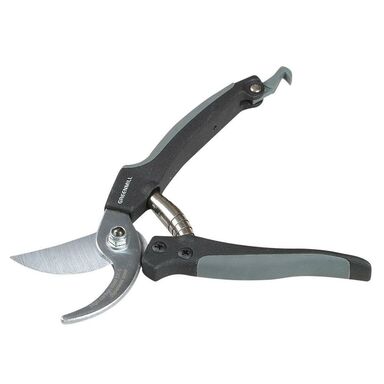 Secateurs are used to cut fruit trees and shrubs, balls and knives. Secateurs are most versatile. We divide them into: handmade, ambidextrous, pole and pneumatic. Hand secateurs can be single-edged or double-edged, and single-blade secateurs can have a flat shear or knife bar. The design of the secateurs affects the work efficiency, the force needed to cut the shoot and to condition the cut wound.
Secateurs are used to cut fruit trees and shrubs, balls and knives. Secateurs are most versatile. We divide them into: handmade, ambidextrous, pole and pneumatic. Hand secateurs can be single-edged or double-edged, and single-blade secateurs can have a flat shear or knife bar. The design of the secateurs affects the work efficiency, the force needed to cut the shoot and to condition the cut wound.
Perfect manual secateurs with knife shears are secateurs of the Swiss company "Felco" and the English company "Wilkinson". Felco secateurs were imported to the country in small quantities. Some artisanal cooperatives in the country produce "Felco" style secateurs, but they are much worse than the Swiss ones. A large selection of hand pruners of various sizes and shapes is provided by Fabryka Wyrobów Kożowych "Gerlach" in Drzewica. Their quality is average. Only large secateurs from this factory are suitable for cutting trees in the orchard. Hand secateurs with a "Rolcut" shearbar are produced in small quantities by craft cooperatives. Their quality varies. Hand secateurs can be used to cut shoots with a diameter of up to 15 mm. Two-handed secateurs are used to cut thicker shoots. Currently on sale are good quality ambidextrous secateurs from the "Gerlach”. A two-handed secateurs can cut shoots with a diameter of up to 25 mm.
Among the pole secateurs, a pruner of the construction of the Research Institute of Pomology and Floriculture in Skierniewice with a rigid lever is useful for cutting trees.. It enables cutting shoots with a diameter of up to 25 mm. These types of secateurs are produced in small quantities by craft cooperatives. String loppers with a lever are not suitable for cutting trees in orchards.
In Western Europe and America, pneumatic secateurs are commonly used to cut trees, that make work much easier. Pneumatic secateurs consist of a compressor, wires, handle and cutting blade. The compressor is usually suspended from a tractor and driven by a power take-off shaft. It is predicted, that in the coming years, suitable compressor sets will be produced domestically, while the pneumatic secateurs will be imported from Italy. A pneumatic pruner can cut shoots with a diameter of up to 40 mm.
Gardening balls are used to cut branches and limbs. The sale includes balls without a headband, handballs, pole balls and balls with a headband. Handballs without a shackle are best for pruning trees in orchards, slightly curved, called "fox tail". Good quality balls of this type are produced by the Saw and Tools Factory in Wapiennica. In old orchards pole balls or mechanical balls are useful.
Less and less frequently used for cutting young trees in orchards a garden knife called a sickle (characteristic. 44). Cutting with a knife has this advantage, that the cut wounds are even and smooth. Compared to pruning shears, knife cutting is ineffective. Only a skilled worker may cut the knife, otherwise you may be seriously injured.
The choice of cutting tools has a great impact on the productivity and effort of the worker. Interesting research on this subject was carried out by Matecki at the Institute of Pomology and Floriculture in Skierniewice. He stated, that on fruiting cut trees every year until 90 % the cut shoots have a diameter of up to 15 mm, which means, that these shoots can be pruned with a hand pruner. The time of cutting one shoot with a hand pruner is very short and therefore its work is the most efficient.
The effort involved in cutting with a hand pruner is greater than with a two-handed or pneumatic pruner. Cutting with a hand pruner, although efficient, it is tedious and requires strong hands. When hiring workers unused to cutting or women in the orchard, ambidextrous secateurs are much better. They save the worker's strength. A two-handed secateurs can be cut 95% shoots. The remaining shoots and branches are cut with a ball.
The least amount of effort is to work with a pneumatic pruner. The latest models of these secateurs are very light and do not tire your hands. Working here is limited to pressing a button. When cutting a large number of small shoots, pneumatic pruning shears do not increase the efficiency of work in relation to manual pruning shears. An employee with a pneumatic pruner is less efficient than an employee with a manual pruner. The advantage over manual cutting is gained, when cutting involves cutting thicker shoots, because there is practically no need to reach for the ball. In rowed orchards, where trees form a continuous wall, if properly organized, work efficiency can be increased by 30-40% by using pneumatic secateurs instead of manual secateurs. In that case, one compressor is serving 2 the 4 sekatory.
The number and thickness of cut shoots on trees varies widely and depends on many factors. Matecki passes, that on fully grown apple trees (age 17-19) those grafted on Antonovka are cut from 150-250 shoots in variety Jonatan i 260-470 shoots in the variety Bankroft. The employee must perform at least one working day 5 thousand cuts, the quality of the tools therefore plays a huge role.